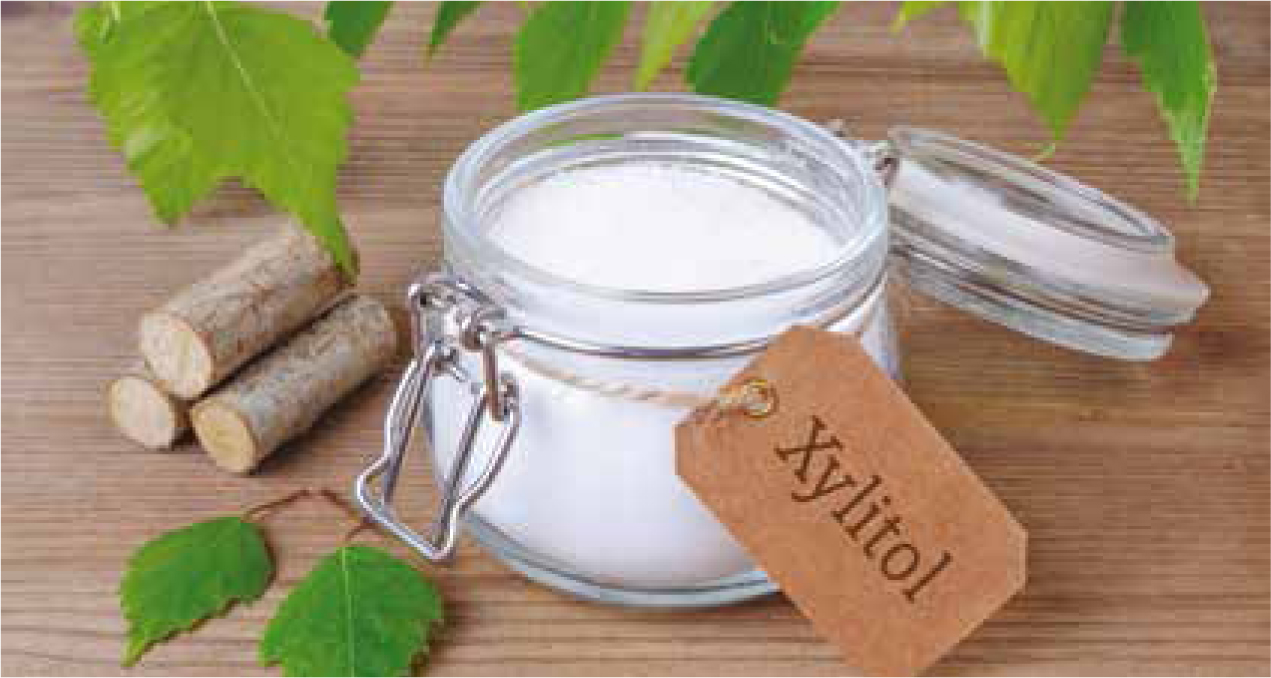Xylitol is a 5-carbon sugar alcohol. It exists naturally in low concentrations in fruit and vegetables and is a normal intermediary metabolite in glucose metabolism. It is manufactured by extracting a precursor from hardwoods and is most commonly encountered as a sweetener in a wide variety of foods.
Sources of xylitol
Xylitol is found in numerous products (Box 1). It is used as a sweetener and is frequently found in sugar-free chewing gums (Figure 1) and confectionary where it protects against tooth decay. It is also present in some toothpastes. It has multiple effects on oral hygiene including the inability of oral bacteria to use it as an energy source (Nayak et al, 2014). Although, xylitol is found in some drinking water additives for animals at low concentrations to decrease dental plaque and calculus formation by inhibiting growth of oral bacteria (Clarke, 2006), this is generally not a source of poisoning in pets (Murphy and Coleman, 2012). It is also found as an excipient in some human and veterinary medicines. It is often found in chewable medicines including nicotine gums and lozenges for smoking cessation.

Xylitol is found in some ice cream and peanut butters (usually speciality brands). Xylitol lowers the calories and the glycaemic index in products and the glycaemia index. Xylitol is not broken down, denatured or modified in baking or cookery processes and is available as a granulated powder (Figure 2) for use as a sugar replacement in baking, so home-baked cakes (Figure 3), muffins and biscuits are also a potential source of xylitol exposure.


It is important to note that on some food packaging xylitol may only be listed by its food additive code, E967.
In America xylitol has also been used to lace baits for the control of predators such as wolves and coyotes (Talcott et al, 2015).
It is important when presented with a dog with hypoglycaemia to determine if it may have been exposed to a potential source of xylitol.
Species differences
Xylitol is toxic to dogs and causes hypoglycaemia (due to insulin release) and liver damage, but this is not seen in cats. Doses of up to 1000 mg/kg have been tested in cats without significant changes in haematological or biochemical parameters (Jerzsele et al, 2018). In addition, acute oral administration of xylitol does not cause hypoglycaemia or severe liver damage in rabbits (Wang et al, 1973) or rodents (Truhaut et al, 1977; Ellwood et al, 1999).
Intravenous xylitol stimulates insulin release in goats and cows (the effect of oral xylitol is unknown), but xylitol has little effect in horses and primates (including humans) (Kuzuya et al, 1971).
There appear to be no studies on the effects of xylitol in birds but 29 wild Cape sugarbirds (Promerops cafer) died acutely after drinking a homemade xylitol nectar solution from a bird feeder. Signs occurred within 15 minutes and death occurred rapidly (Gardner et al, 2017).
The reasons for these species differences in the response to xylitol are unknown.
Mechanism of action
In dogs xylitol has two main effects: hypoglycaemia and liver damage.
Hypoglycaemia
Xylitol is a potent stimulator of insulin release in dogs and this causes a decrease in blood glucose. Experimental studies have shown that oral or intravenous administration of xylitol can cause a dose-dependent and rapid increase in insulin concentrations resulting in a decrease in glucose concentrations in dogs (Hirata et al, 1966; Kuzuya and Kanazawa, 1969; Kuzuya et al, 1969; Asano et al, 1977). In dogs, xylitol is more effective than glucose in stimulating insulin release (Asano et al, 1977), particularly at high doses (Kuzuya et al, 1969), but is thought to act on the pancreas in a similar way to glucose. In addition, dogs appear to absorb xylitol at a faster rate and more extensively than humans (Kuzuya et al, 1969).
In an experimental study in dogs the insulin concentration increased from 20 minutes after oral administration of xylitol (1 or 4 g/kg) and the blood glucose concentration started to fall from 30 minutes. There was also a fall in blood potassium and phosphorous concentrations from 30–60 minutes and an increase in liver enzymes which was dose-related and noted by 4 hours (Xia et al, 2009).
The electrolyte changes seen with xylitol toxicosis are due to the effect of insulin shifting magnesium and potassium into cells resulting in low blood concentrations.
Based on first principles, xylitol is likely to have a minimal effect on the blood glucose in diabetic dogs since diabetes is usually due to insulin deficiency or interference with the action of insulin.
Liver failure
The mechanism of xylitol-induced liver damage is unknown. It may be due to prolonged adenosine triphosphate (ATP) depletion from xylitol metabolism resulting in cellular necrosis or production of reactive oxygen species that damage cell membranes and macromolecules (Dunayer and Gwaltney-Brant, 2006).
Toxic dose
A dose of 0.05 g/kg (50 mg/kg) xylitol can cause hypoglycaemia in dogs (Box 2). A dose of more than 0.5 g/kg (500 mg/kg) can cause liver failure, although this may be idiosyncratic rather that a dose-related effect (Dunayer, 2006) since not all dogs that ingest more than 0.5 g/kg develop liver failure (Piscitelli et al, 2010).
The xylitol content of many products is not provided on the packaging; for medicines this is because it is an excipient and not an active ingredient. A poisons information centre may be able to help or give guidance on the possible maximum concentration in the type of products involved, as poisons information centres actively seek this information from manufacturers. The amount of xylitol in sugarfree gums varies enormously (1–90%).
In many cases, however, it may not be possible to determine how much product has been eaten; the dog may have eaten or chewed the packaging, or the owner may not recall how much product was remaining.
Clinical effects
Onset
Xylitol-induced hypoglycaemia can occur within an hour (Dunayer, 2006), but may be several hours after ingestion of chewing gum (up to 12 hours in some cases). This delay in hypoglycaemia with xylitol-containing chewing gums is likely due to the formulation and because dogs generally do not chew the gum and swallow it whole (Murphy and Coleman, 2012). In some cases, particularly those with subsequent liver damage, hypoglycaemia can be delayed 24–48 hours (Dunayer and Gwaltney-Brant, 2006). Liver failure can occur in the absence of hypoglycaemia and signs occur 2–72 hours after ingestion (Dunayer and Gwaltney-Brant, 2006; Murphy and Coleman, 2012; Schmid and Hovda, 2016), but liver enzymes generally start to rise within 4–24 hours (Xia et al, 2009; Murphy and Coleman, 2012).
Hypoglycaemia
The fall in blood sugar in dogs after ingestion of xylitol is due to stimulation of insulin release. Clinical features of hypoglycaemia include tachycardia, ataxia, lethargy, weakness, coma, convulsions, hemiparesis, hypokalaemia, hypomagnesaemia and hypophosphataemia. Vomiting is common after ingestion of xylitol (Dunayer, 2006).
With severe hypoglycaemia there may be metabolic acidosis, status epilepticus, cerebral oedema, hypotension, ventricular tachycardia and cardiovascular collapse. Permanent neurological sequelae may occur, usually as a result of delayed recognition and prolonged hypoglycaemia.
See Box 3 for other potential causes of hypoglycaemia in dogs.
Hyperglycaemia may sometimes occur with xylitol ingestion and this is a result of the Somogyi phenomenon (rebound hyperglycaemia or post-hypoglycaemic hyperglycaemia) that can occur with insulin overdose.
Liver failure
There are numerous reports of xylitol-induced liver failure in dogs (Foss, 2004; Dunayer and Gwaltney-Brant, 2006; Todd and Powell, 2007; Schmid and Hovda, 2016). There is raised alanine aminotransferase (ALT) and aspartate aminotransferase (AST), with a less marked rise in alkaline phosphatase (ALP), and elevated bilirubin. More rarely there is prolonged clotting time, thrombocytopenia and hyperphosphataemia.
Treatment
Aggressive treatment is recommended in dogs after ingestion of xylitol.
Gut decontamination
If the dog has not vomited already, ingestion occurred within one hour and the dog is asymptomatic, emesis can be induced. Emesis is generally not recommended in dogs with clinical signs of hypoglycaemia, as there is a risk of aspiration if the dog has hypoglycaemic-induced central nervous system (CNS) depression. Xylitol is also rapidly absorbed so delayed emesis is unlikely to be useful. The binding of xylitol to activated charcoal is low, but may still be beneficial, particularly if a large dose has been ingested (Cope, 2004).
Monitoring
Dogs that have ingested a potentially toxic dose of xylitol should be admitted for monitoring. The following parameters should be obtained as baseline and monitored: blood glucose every 1–2 hours for at least 12 hours (Dunayer, 2006); potassium and phosphorus concentrations every 4–6 hours and corrected if necessary (Piscitelli et al, 2010); total bilirubin, liver enzymes, platelets, erythrocyte count and clotting parameters every 24 hours for at least 72 hours (Dunayer, 2006).
As regular sampling is required in these patients it may be beneficial to use a sampling line. If this is not an option, it may be more practical to use an insulin syringe to blood sample, and EMLA cream (containing lidocaine and prilocaine) to minimise stress to the patient.
It is also important to monitor the dog's mentation and cardiovascular status, as these can change in animals with low blood glucose concentrations.
Initial management
An antiemetic may be required to control vomiting. In dogs without clinical features of hypoglycaemia frequent small meals or oral sugar may be given for 8–12 hours (Dunayer, 2004).
Dogs that have ingested more than 0.5 g/kg (500 mg/kg) should be started on intravenous dextrose therapy with monitoring of the blood glucose ever 2–4 hours (Dunayer, 2006). Dextrose therapy can be stopped after 24 hours if the blood glucose remains normal (Piscitelli et al, 2010).
Dogs that have ingested a potentially hepatotoxic dose should also be started on liver protectants, although their efficacy in xylitol-induced liver damage has not been evaluated. S-adenosyl-L-methionine (SAMe, 20 mg/kg orally), silymarin (50 mg/kg orally) or acetylcysteine can be considered (Piscitelli et al, 2010). For acetylcysteine the paracetamol treatment regimen can be used (oral or intravenous (IV) 140 mg/kg then 70 mg/kg orally every 6 hours for 36 hours or more).
Supportive fluid therapy may be required, particularly if the dog is not eating or drinking or requires rehydration following vomiting. Electrolyte supplementation may be required, and this can be given orally or intravenously, depending on the clinical condition of the dog and severity of biochemical changes.
Management of hypoglycaemia
If feeding is ineffective or the dog is symptomatic then the hypoglycaemia should be corrected with an intravenous bolus dose of 1 ml/kg of 50% dextrose (0.5 g/kg) diluted 1:2 in crystalloid solution (Piscitelli et al, 2010). A 2.5% or 5% dextrose constant rate infusion may be required in severe cases to maintain blood glucose.
If possible the electrocardiogram (ECG) should be monitored because hypokalaemia can cause arrhythmias.
Management of liver damage
The management of dogs in liver failure is supportive. Plasma transfusions and vitamin K1 may be required in animals with coagulopathy.
Prognosis
The prognosis for uncomplicated xylitol-induced hypoglycaemia that is managed promptly is good. Mild increases in liver enzymes usually resolve within a few days if supportive care is provided. The prognosis in dogs with repeated episodes of severe hypoglycaemia or severe elevation of liver enzymes with clotting abnormalities is guarded to poor. Hyperphosphataemia, which occurs secondary to liver failure, is also a poor prognostic indicator (Dunayer, 2006; Murphy and Coleman, 2012).
Conclusion
Xylitol can cause rapid onset hypoglycaemia in dogs followed by liver failure in some cases, although the hepatotoxic effect is not dose-related. Management includes gut decontamination if the dog presents early, followed by monitoring of blood sugar and liver parameters. The blood glucose should be corrected with dextrose if required and liver protectants should be considered in dogs that have ingested more than 0.5 g/kg. Prognosis is good in dogs with corrected hypoglycaemia and no complications of liver failure.

